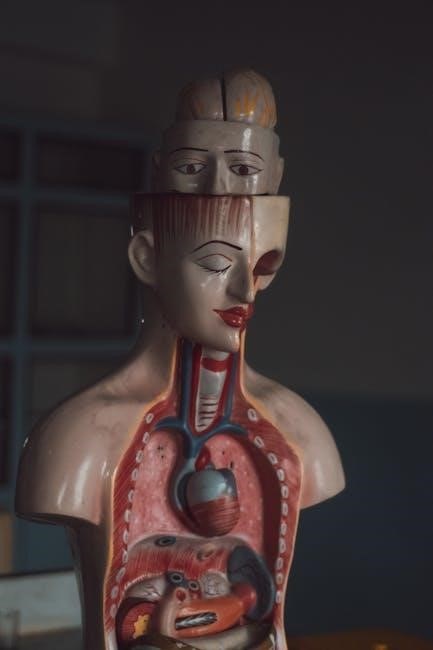The human body is a complex network of cells‚ tissues‚ and organs that work together to sustain life. It comprises 11 interconnected systems‚ each with unique functions essential for maintaining overall health and enabling the body to function efficiently.

Overview of the 11 Human Body Systems
The human body consists of 11 intricate systems‚ each performing unique roles to maintain health and functionality. These systems—nervous‚ circulatory‚ respiratory‚ digestive‚ urinary‚ muscular‚ skeletal‚ integumentary‚ endocrine‚ reproductive‚ and immune—work interdependently to sustain life and ensure all bodily functions operate harmoniously.
Nervous System (Signaling and Control)
The nervous system is the body’s communication and control center‚ enabling rapid signal transmission and coordination of various bodily functions. It consists of the central nervous system (CNS)‚ including the brain and spinal cord‚ and the peripheral nervous system (PNS)‚ comprising nerves that connect the CNS to the rest of the body.
The CNS processes information‚ controls voluntary actions like walking‚ and manages involuntary functions such as breathing. Neurons‚ specialized cells‚ transmit signals through electrical impulses and chemical neurotransmitters‚ allowing communication across synapses. This system also regulates emotions‚ thoughts‚ and responses to stimuli‚ making it essential for overall bodily coordination and function.

Circulatory System (Blood Circulation and Oxygen Transport)
The circulatory system‚ also known as the cardiovascular system‚ is responsible for transporting oxygen‚ nutrients‚ and hormones throughout the body while removing waste products. It consists of the heart‚ blood vessels‚ and blood. The heart acts as a pump‚ pushing blood through arteries‚ veins‚ and capillaries to deliver oxygen to tissues and organs.
Arteries carry oxygen-rich blood away from the heart to the body‚ while veins return oxygen-depleted blood to the heart. Capillaries‚ the smallest blood vessels‚ facilitate the exchange of oxygen‚ nutrients‚ and waste products with tissues. Blood itself is a vital component‚ composed of red blood cells (which transport oxygen)‚ white blood cells (for immune defense)‚ and platelets (for clotting). This system ensures that every cell receives the necessary resources for function and survival‚ making it a cornerstone of life and overall bodily function.
Respiratory System (Gas Exchange and Breathing)
The respiratory system is a vital network of organs and tissues responsible for the exchange of oxygen and carbon dioxide through the process of breathing. It includes the nose‚ trachea‚ bronchi‚ lungs‚ and alveoli‚ which work together to facilitate gas exchange.
When we inhale‚ air enters the body through the nose or mouth‚ passes through the trachea‚ and divides into bronchi that lead to the lungs. The air then reaches the alveoli‚ tiny sacs where oxygen diffuses into the bloodstream and carbon dioxide is removed. This process is essential for delivering oxygen to cells and organs throughout the body.
The diaphragm‚ a muscular sheet‚ plays a key role in breathing by contracting and relaxing to expand and deflate the chest cavity. The respiratory system also filters‚ warms‚ and humidifies the air we breathe‚ protecting the body from harmful particles. Additionally‚ it aids in the removal of waste gases‚ such as carbon dioxide‚ through exhalation.
This system is crucial for maintaining proper bodily functions‚ as oxygen is necessary for cellular energy production. Its intricate design ensures efficient gas exchange‚ enabling the body to function optimally and sustain life. Disorders in this system can lead to serious health issues‚ emphasizing its importance in overall well-being.

Digestive System (Nutrient Absorption and Waste Elimination)
The digestive system is a complex process that involves the breakdown of food into nutrients that the body can absorb and use for energy‚ growth‚ and repair. It consists of a series of organs and tissues that work together to transform ingested food into a usable form.
The process begins in the mouth‚ where teeth chew food and enzymes in saliva start breaking it down. The esophagus then transports the food to the stomach‚ where gastric juices further digest it into a liquid mixture. This mixture moves into the small intestine‚ where most nutrient absorption occurs. The walls of the small intestine are lined with finger-like projections called villi‚ which increase the surface area for absorption.
The remaining waste products enter the large intestine‚ where water is absorbed‚ and the waste is prepared for elimination through the rectum and anus. Enzymes and bacteria in the digestive tract play a crucial role in breaking down complex molecules like carbohydrates‚ proteins‚ and fats into simpler forms. This system is essential for providing the body with the necessary nutrients to function properly and sustain life.
Urinary System (Waste Removal and Fluid Balance)
The urinary system is a vital component of the human body‚ responsible for removing waste products and maintaining fluid balance. It consists of the kidneys‚ ureters‚ bladder‚ and urethra‚ working together to filter blood‚ produce urine‚ and eliminate waste.
The kidneys‚ located in the lower back‚ are the primary organs of this system. They filter blood to remove waste products‚ such as urea‚ and excess substances like water and electrolytes. This process results in the production of urine‚ which then travels through the ureters to the bladder for storage.
The bladder stores urine until it is full‚ at which point the urethra expels it from the body. The urinary system also plays a role in regulating the body’s pH levels and maintaining electrolyte balance by adjusting the excretion of water and ions. Hormones‚ such as antidiuretic hormone‚ help control the amount of water reabsorbed by the kidneys.
Proper functioning of the urinary system is essential for overall health‚ as it prevents the buildup of toxins and helps maintain homeostasis. Any disruption in this system can lead to conditions like kidney stones‚ infections‚ or chronic diseases‚ emphasizing its importance in sustaining life and bodily functions.
- Key functions: Waste removal‚ fluid balance regulation‚ pH balance‚ electrolyte management.
Muscular System (Movement and Support)
The muscular system is essential for movement‚ support‚ and stability in the human body. It consists of over 600 muscles‚ which account for approximately 40% of the body’s weight. These muscles are divided into three types: skeletal‚ smooth‚ and cardiac.
Skeletal muscles are attached to bones and enable voluntary movements‚ such as walking‚ running‚ and lifting. Smooth muscles‚ found in internal organs like the digestive tract‚ function involuntarily‚ aiding in processes like digestion. Cardiac muscle‚ exclusive to the heart‚ ensures the continuous pumping of blood.
The muscular system works in conjunction with the skeletal system‚ with muscles pulling on bones to create movement. It also provides structural support‚ protecting internal organs and maintaining posture. Additionally‚ muscles play a role in regulating body temperature through shivering and generating heat.
Dysfunction in the muscular system can lead to conditions like muscle atrophy‚ strains‚ or spasms; Proper care‚ including exercise and nutrition‚ is vital for maintaining muscle health and overall mobility.
- Key functions: Movement‚ support‚ stability‚ heat production‚ and organ protection.
Skeletal System (Structural Support and Protection)
The skeletal system forms the structural framework of the human body‚ providing support‚ protection‚ and facilitating movement. Comprising 206 bones and joints‚ it serves as the body’s internal framework‚ enabling posture and locomotion.
One of its primary functions is to protect vital organs‚ such as the brain‚ heart‚ and lungs‚ by encasing them in bony structures like the skull and ribcage. Additionally‚ the skeletal system produces blood cells in the bone marrow‚ a process essential for immune function and oxygen transport.
Bones also act as storage sites for minerals like calcium and phosphorus‚ which are crucial for maintaining bone health and overall bodily functions. The skeletal system works in tandem with the muscular system‚ allowing for voluntary movement through the contraction and relaxation of muscles attached to bones.
There are two main categories of bones: the axial skeleton‚ which includes the skull‚ spine‚ and ribcage‚ and the appendicular skeleton‚ comprising the limbs and pelvis. Joints‚ such as the knees and elbows‚ enable flexibility and mobility‚ while ligaments and tendons provide stability and connection between bones and muscles.
- Key functions: Structural support‚ organ protection‚ blood cell production‚ mineral storage‚ and movement facilitation.
Integumentary System (Protection and Regulation)

The integumentary system is the largest organ system in the human body‚ playing a vital role in protection‚ regulation‚ and interaction with the environment. It consists of the skin‚ hair‚ nails‚ and associated glands‚ working together to maintain bodily integrity and function.
The skin‚ the system’s primary component‚ acts as a protective barrier against pathogens‚ physical damage‚ and environmental factors like UV radiation. It also regulates body temperature through sweating and helps maintain fluid balance by controlling water loss. Additionally‚ the integumentary system aids in the production of vitamin D‚ essential for bone health‚ through sunlight exposure.
The skin is composed of multiple layers: the epidermis (outermost layer)‚ dermis (middle layer with blood vessels and nerve endings)‚ and hypodermis (innermost layer of fatty tissue). Hair and nails provide additional protection‚ while sebaceous and sweat glands contribute to skin lubrication and temperature regulation.
- Key functions: Protection‚ temperature regulation‚ vitamin D synthesis‚ and fluid balance maintenance.
This system is crucial for overall health‚ as it shields internal organs and aids in maintaining homeostasis‚ ensuring the body operates efficiently.

Endocrine System (Hormone Production and Regulation)

The endocrine system is a network of glands that produce and regulate hormones‚ which are chemical messengers controlling various bodily functions. These hormones influence growth‚ metabolism‚ reproductive processes‚ and overall physiological balance.
The system includes key glands such as the pituitary gland (often called the “master gland”)‚ thyroid gland‚ pancreas‚ adrenal glands‚ and gonads (ovaries and testes). The pituitary gland regulates the activity of other endocrine glands‚ while the thyroid gland controls metabolism. The pancreas produces insulin and glucagon to manage blood sugar levels‚ and the adrenal glands produce adrenaline for stress responses. The gonads are responsible for sex hormones‚ such as estrogen and testosterone.
Hormones are secreted directly into the bloodstream‚ traveling to target cells to initiate specific responses. For example‚ insulin lowers blood sugar‚ while thyroid hormones increase metabolic rate. The endocrine system works closely with the nervous system to maintain homeostasis and ensure proper bodily functions.
Dysregulation of the endocrine system can lead to disorders like diabetes‚ thyroid conditions‚ or hormonal imbalances‚ highlighting its critical role in overall health.
Reproductive System (Reproduction and Genetic Transfer)
The reproductive system is responsible for producing sex cells‚ enabling reproduction‚ and supporting the development of a new organism. It ensures the continuation of genetic material from one generation to the next.

In males‚ the reproductive system includes the testes‚ which produce sperm‚ and the penis‚ which delivers sperm during ejaculation. The female reproductive system consists of the ovaries‚ which produce eggs‚ the fallopian tubes‚ where fertilization occurs‚ the uterus‚ which nurtures a developing fetus‚ and the vagina‚ the birth canal.
The system facilitates sexual reproduction through processes like gamete formation‚ fertilization‚ and embryonic development. Hormones such as estrogen and testosterone regulate reproductive functions‚ ensuring proper development and maintenance of reproductive organs.
Dysfunction in the reproductive system can lead to infertility or disorders like polycystic ovary syndrome (PCOS) or erectile dysfunction‚ emphasizing its importance in human health and reproduction.
Immune and Lymphatic Systems (Defense and Immunity)
The immune and lymphatic systems are vital for protecting the body against infections‚ diseases‚ and foreign substances. They work together to maintain immunity and overall health.
The lymphatic system consists of lymph nodes‚ the spleen‚ and lymphatic vessels. It filters lymph fluid‚ traps pathogens‚ and aids in detoxification. This system also plays a role in absorbing fats and fat-soluble vitamins from the digestive tract.
The immune system is the body’s defense mechanism‚ comprising white blood cells like lymphocytes and neutrophils. It identifies and neutralizes threats such as bacteria‚ viruses‚ and toxins through innate and adaptive immune responses. Innate immunity provides immediate‚ non-specific protection‚ while adaptive immunity offers targeted‚ long-term defense.
Dysfunction in these systems can lead to immune deficiencies‚ autoimmune disorders‚ or lymphatic blockages. Proper functioning ensures the body can fight infections‚ heal injuries‚ and maintain homeostasis.

Together‚ the immune and lymphatic systems are essential for safeguarding the body and enabling it to recover from illness and injury.
